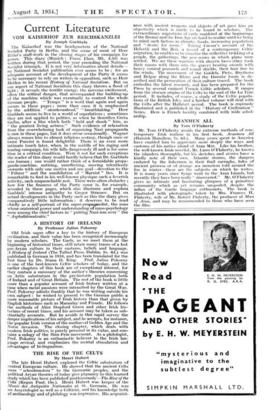THE RISE OF THE CELTS
By Henri Hubert
The late Henri Hubert explored the Celtic substratum of central European culture. He showed that the ancient Celts were " schoolmasters " to the Germanic peoples, and the political Aryan theories of today give piquancy to this learned study which has been published posthumously—The Rise of the Celts (Kegan Paul, 16s.). Henri Hubert was keeper of the Mus& des Antigun& Nationales at St. Germain. He was an Assyriologist as well as a Celticist, and his knowledge both of archaeology and of philology was impressive. His acquaint- ance with ancient weapons and objects of art gave him an objectivity which is rarely to be found in scholars. The extraordinary migrations of early mankind at the beginnings of the Bronze and the Iron Age are hard to realize until we bring to mind such factors as climate, floods, increasing population and "desire for room." Taking Caesar's account of the Helvetii and the Boii, a record of a contemporary Celtic migration, he enables us to visualize the collective trekking of a people, the gatherings, the pow-wows in which plans were settled. We see these warriors with shaven faces (they took their razors with them into the grave) bearing swords with heavy conical pommels and round shields, their hair free to the winds. The movement of the Goidels, Picts, Brythons and Belgae along the Rhine and the Danube basin is de- scribed and the permeation of their culture traced. The book embodies the latest research, and has been prepared for the Press by several eminent French Celtic scholars. It ranges from the obscure origins of the Celts to the end of the La Tene period. It includes, of course, a study of the Celtic popula- tions of the British Isles, and a further volume will deal with the Celts after the Hallstatt period. The book is copiously illustrated and is published in the "History of Civilisation" Series. Here is French lucidity combined with wide schol- arship.






























 Previous page
Previous page